N-O
| the telling of a story, and the supplemental information given to the film audience by an off-screen voice; sometimes the narrator is a character in the film, who provides information in a flashback; see also voice-over. |
 Examples: during the opening credits in Casablanca (1942), and throughout Letter from an Unknown Woman (1948); also the lyrics-as-narration (by the Doors' song 'The End') in the opening of Apocalypse Now (1979) Examples: during the opening credits in Casablanca (1942), and throughout Letter from an Unknown Woman (1948); also the lyrics-as-narration (by the Doors' song 'The End') in the opening of Apocalypse Now (1979) |
|
| a structured series of events, linked by cause and effect, that provide the plot of a film; a film that tells a chronological or linear story (with a beginning, middle, and end), as opposed to non-narrative films, such as poetic or abstract films. | ||
(naturalistic) |
a stage, artistic, philosophical, or literary term as well as a film term, signifying an extreme form of realismin which life is depicted in a stoic, unbiased way; see also Neo-Realism. | Examples: Dead End (1937), The Asphalt Jungle (1950), On the Waterfront (1954) |
| refers to film that has an inverted record of the light and dark areas of the photographed scene | ||
| an influential movement of the late 1940s and 1950s that originated in Italy; inaugurated by Jean Renoir, but associated with Italian post-war directors (Rossellini, Visconti, and De Sica); refers to films made outside the studio, with shooting on real locations, sometimes the absence of a script and/or non-professional casts and actors - all designed simultaneously to cut costs and increase the impression of spontaneity; neo-realistic films often deal with contemporary social and political issues; see also naturalism. | Example: De Sica's definitive The Bicycle Thief (1948, It.) | |
| originally referred to the "Big Three" (ABC, NBC and CBS), but now with additional competitors, including Fox Channel, often known as 'free-TV' | Example: the prescient Network (1976) forecast the development of a fourth sensationalist network, with its fictional UBS channel that specialized in reality television programming | |
| also known as Nouvelle Vague; originally referred to a group of individualistic, innovative, and non-traditional French filmmakers, directors and producers in the late 1950s and early 1960s, including Francois Truffaut, Jean-Luc Godard, Claude Chabrol, Eric Rohmer, and Alain Resnais, who began as critics on Cahiers du Cinema and espoused the principles of auteur theory; the New Wave film style was characterized by a cinema verite style with the use of the jump cut, the hand-held camera, non-linear storytelling, and loose, improvised direction; now used to generally refer to any new movement in a national cinema. | 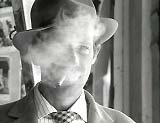 Examples: Chabrol's Le Beau Serge (1958) (aka Bitter Reunion), Truffaut's feature film debut The 400 Blows (Les Quatre Cents Coups) (1959), Godard's Breathless (A Bout de Souffle) (1959), Marcel Camus' Black Orpheus (1959), Chabrol's Les Cousins (1959), and Resnais' Hiroshima Mon Amour (1959) Examples: Chabrol's Le Beau Serge (1958) (aka Bitter Reunion), Truffaut's feature film debut The 400 Blows (Les Quatre Cents Coups) (1959), Godard's Breathless (A Bout de Souffle) (1959), Marcel Camus' Black Orpheus (1959), Chabrol's Les Cousins (1959), and Resnais' Hiroshima Mon Amour (1959) |
|
| refers to a filmed cinema news report | ||
| the term for a makeshift motion picture theater, often a converted store, which proliferated all over the US, mostly in working-class areas of metropolitan centers, during the first decade of the 20th century. The name was derived from the 5 cents/nickel charged to patrons. | 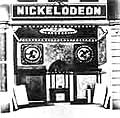 A nickelodeon or 'storefront theatre' from the late 1800s or early 1900s. |
|
| a dark and brooding film that features a downbeat, depressing, dreary, cynical, gloomy or bleak tone; often doom-laden and concerned with the subjects of death, suffering, tragedy, unhappiness, and existential despair; the protagonist often meets with death or tragedy in a film's conclusion; see also dystopia. | Examples: Almost all film noirs are nihilistic, such as The Killers (1946), D.O.A. (1950), Sunset Boulevard (1950), Kiss Me Deadly (1955), A Clockwork Orange (1971), Taxi Driver (1976), and American Beauty (1999) | |
| a highly-flammable kind of film base, composed of cellulose nitrate, used up until the late 1940s when it was then supplanted by acetate base. |
 Example: deteriorating and powdery nitrate-based film, one of the most important reasons for film archival work and preservation. Example: deteriorating and powdery nitrate-based film, one of the most important reasons for film archival work and preservation. |
|
| see film noir, tech-noir | ||
| a small role in a film, usually a brief appearance on screen, that has no dialogue but where the individual is clearly identifiable and usually appears in the credits; see also extra, cameo, bit, and walk-on. | ||
(non-synchronized) |
refers to a scene shot without synchronized sound - and sounds must be added later during the editing stage; sync sound is its opposite; also refers to a mis-matched soundtrack; aka asynchronous | |
| a movement, now officially headed by the Non-Traditional Casting Project (NTCP) to "promote inclusive hiring practices and standards, diversity in leadership and balanced portrayals of persons of color and persons with disabilities"; not to be confused with cast against type or miscast | Example: Morgan Freeman as Red in The Shawshank Redemption (1994) - a role originally written for an Irish character | |
| A film that wistfully looks back at an earlier past time, often depicting it as more innocent and uncomplicated than it actually was, historically; nostalgia films usually look back on the protagonist's or narrator's childhood. See also coming of agefilm. | Examples: How Green Was My Valley (1941), Amarcord (1973), American Graffiti (1973), A Christmas Story (1983), Radio Days (1987), Cinema Paradiso (1988, It./Fr.), Avalon (1990), Crooklyn (1994), The Inkwell (1994). | |
| refers to making a novel from a film or screenplay | ||
| an abbreviation, refers specifically to National Television System Committee that sets TV and video standards; also refers to the US, Canada and Japanese video display systems that have 525 horizontal scan lines of resolution, 16 million different colors, at 30 frames per second (or 60 half-frames (interlaced) per second); competing systems in Europe and worldwide are PAL (Phase Alternating Line) and SECAM (Sequential Color with Memory) | ||
(or nudie flick) |
an old term for a pornographic movie, often used during the age of the Hayes Code when nudity was forbidden by censors in mainstream films on the silver screen; an era of nudie films was generated by filmmaker Russ Meyer in the late 50s; also see porn. | 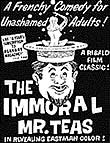 Examples: Russ Meyer's cheaply-made The Immoral Mr. Teas (1959) was known as a 'nudie-cutie'. Ecstasy (1933) and Blow-Up (1966) - examples of two other films with nudity that generated controversy when first released Examples: Russ Meyer's cheaply-made The Immoral Mr. Teas (1959) was known as a 'nudie-cutie'. Ecstasy (1933) and Blow-Up (1966) - examples of two other films with nudity that generated controversy when first released |
| in the movie-theatre business, refers to operating expenses associated with a film (the exhibitor's calculation of what it takes to lease his theater, to staff and run it, etc.); aka house nut | ||
| a cliched and expected scene for a particular genre, e.g., a love scene in a romance or dramatic film, a shoot-out in a Western, the solving of a crime in a mystery, a rescue in an action film, etc. | 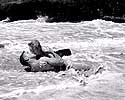 Example: The famous waves-churning embrace in From Here to Eternity (1953) Example: The famous waves-churning embrace in From Here to Eternity (1953) |
|
(or off-camera) |
refers to action or dialogue off the visible stage, or beyond the boundaries of the camera's field of vision or depicted frame; aka off-screen | |
| refers to a performer who has no need for a script (or book), after completely memorizing all lines of dialogue | ||
point-of-view (POV) |
a film in which the narrator knows (and sees) everything occurring in a story, including character thoughts, action, places, conversations, and events; contrast to subjective point-of-view | |
(or on-camera) |
on the visible stage, or within the boundaries of the camera's field of vision | |
(or line) |
a screen direction rule that camera operators must follow - an imaginary line on one side of the axis of action is made (e.g., between two principal actors in a scene), and the camera must not cross over that line - otherwise, there is a distressing visual discontinuity and disorientation; similar to the axis of action (an imaginary line that separates the camera from the action before it) that should not be crossed |
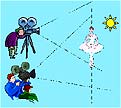 Camera placement must adhere to the 180 degree rule Camera placement must adhere to the 180 degree rule |
| a term for a short, one-line joke (that contains its own punchline); also the term may refer to the 'high concept' description of a film - a few words used to describe a script, storyline or a film's premise that a person can easily understand with a simple one-liner | Examples: (comedic one-liner): "Either he's dead or my watch has stopped!" (Groucho Marx in A Day At the Races (1937)), and (high concept one-liner): "A teenager is mistakenly sent into the past, where he must make sure his mother and father meet and fall in love; he then has to get back to the future." Back to the Future (1985) | |
| a scripted or filmed narrative (or an avant-garde or experimental film) featuring a solo performance piece with only one actor or actress who sometimes plays multiple roles or characters; often presented by a stand-up comedian; contrast with concert film | Examples: Give 'em Hell, Harry! (1975), Paul Robeson (1977), Gilda Live (1980), Secret Honor (1984), Whoopi Goldberg Live (1986), Swimming to Cambodia (1987) (by Spalding Gray), The Search for Signs of Intelligent Life in the Universe (1991)(with Lily Tomlin), and Eric Bogosian's Sex, Drugs, Rock & Roll (1991) | |
| refers to a film 10-12 minutes long | ||
| refers to the typical size of a movie poster | ||
| the presentation of the 'opening credits' (as an introduction to the audience about the film and including selected important members of the production) is known as the opening credits sequence; sometimes it is superimposed on the action, but often exists as static letters on a solid background; since the closing or end creditsusually list the entire cast and production crew, the opening credits sequence is usually positioned to set the mood of the film, and sometimes even lacks any credits except the film's title; aka front credits or beginning titles |
Robocop 2 (1990) and Vanilla Sky (2001) were unusual in that there were no opening credits of any sort, not even the title of the film - an increasing trend! |
|
(or optical effects) |
in film-making, refers to a visual device, e.g., a fade, wipe, dissolve, superimposition, freeze-frame, split-screen, composite (a train reflection in a car window), or another effect, some of which can be created in the camera, and others that have to be achieved in post-production by mixers or other specialized techniques | Example: Star Wars (1977) mimicked the Saturday matinee style of episodic serials with various opticals |
| the name given to the awards of AMPAS (the Academy of Motion Picture Arts and Sciences) given each year to various performers and others in the film industry; officially known as the "Academy Award of Merit" |  The 13.5 inch award statuettes were officially nicknamed Oscars after 1939 |
|
| Often used in a derogatory way to describe studio-invented pre-release PR buzz that a film (usually an epic or serious biopic released late in the year) is worthy, meaningful, and deserving of Oscar awards; the term was reportedly first used by Hedda Hopper in a "Looking at Hollywood" column on June 1, 1948; the term either refers to (1) a self-proclaimed, "important", often over-produced film, undercut by its attempt to appeal to all demographics, or (2) a showy acting performance designed to draw attention to itself; these kinds of films and performances were the sort that used to guarantee an Oscar from Academy voters during the film industry's adolescent years of the 1950's and early 1960's, but are now considered either pretentious and/or cheesy in the modern age, and ironically often hurt the film's or actor's chances at winning an Oscar, though some films still succeed; aka Oscarbation | Examples: The Alamo (1960) and Chill Wills' campaign for a Best Supporting Actor Oscar was the first major example of "Oscar bait" backlash; also Hello, Dolly! (1969), Paint Your Wagon (1969), The Towering Inferno (1974), Inchon (1982); recent examples include The Last Samurai (2003), Alexander (2004), Memoirs of a Geisha (2005) and The Pursuit of Happyness (2006); Around the World in 80 Days (1956), Gandhi (1982) and The English Patient (1996) are examples of successful "Oscar bait"; Christopher Guest's For Your Consideration (2006), a mockumentary about movie-making, examined Hollywood's obsession with awards by its story of an indie production titled Home for Purim. | |
| refers to camera shots that are not included (literally, they are 'taken out') in the final cut or print of a film, often retrieved from the cutting room floor, and shown during the closing credits; also see blooper | Examples: Films with blooper outtakes at the conclusion during the credits include: Cannonball Run (1981), Liar Liar (1997), A Bug's Life (1998), and Toy Story 2 (1999). | |
| poor, overly-broad, or 'over-the-top' acting by a 'ham' actor; aka "hamming it up" or 'chewing up the scenery'; sometimes considered in a positive light as 'campy'; contrast with underacting | 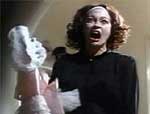 Example: Faye Dunaway in Mommie Dearest (1981). Example: Faye Dunaway in Mommie Dearest (1981). |
|
| refers to speeding up a camera's frame rate - to shoot at more than the normal 24 fps, so that the resulting image, when played back at the normal frame rate, appears to be in slow-motion; this technique is often used to shoot miniatures; the term "cranking' refers to the old technique of having to turn or crank a camera by hand | ||
| refers to a film shot that has more light than normal, causing a blinding, washed-out, whitish, glaring effect; deliberately used for flashbacked or dream scenes; aka flared or bleached; the opposite of underexposed |  Example: the kissing scene in Pride & Prejudice (2005) before a bright sun Example: the kissing scene in Pride & Prejudice (2005) before a bright sun |
|
| the carry-over of dialogue, sounds, or music from one scene to another; occurs when the cut in the soundtrack is not at the same time as the cut in the image; can also refer to two or more characters speaking at the same time; aka overlap sound | Example: Robert Altman's M*A*S*H (1970) | |
| a very commonly-used medium camera angle or view in a dialogue scene, mostly with alternating shot/reverse-shot editing, in which the camera records the action from behind the shoulder and/or head of one of the characters, thus framing the image; the two characters are thus linked or connected to each other, and their positions are established | ||
| in film terms, a pre-credits or opening credits musical selection that sets the mood and theme for the upcoming film | Examples: Most musicals feature an overture (during or before the opening credits) that is comprised of a medley of the main songs of the film, such as West Side Story (1961) and My Fair Lady (1964); some dramatic (or epic) films have overtures as well -- Ligeti's Atmospheres overture in 2001: A Space Odyssey (1968) precedes the opening credits. Pre-credit overtures are often cut in home and television video releases. | |
| slang term for a drive-in movie theater; aka passion pit; see also hard-top (indoor movie theater) | ||
źródło:www.filmsite.org
 Examples: Saul Bass was famous for his opening credits sequences, such as his work on Hitchcock's
Examples: Saul Bass was famous for his opening credits sequences, such as his work on Hitchcock's  the opening of Woody Allen's
the opening of Woody Allen's  and James Cameron's The Abyss (1989) featured the title emerging from blackness and traveling down the "Y" into the ocean
and James Cameron's The Abyss (1989) featured the title emerging from blackness and traveling down the "Y" into the ocean